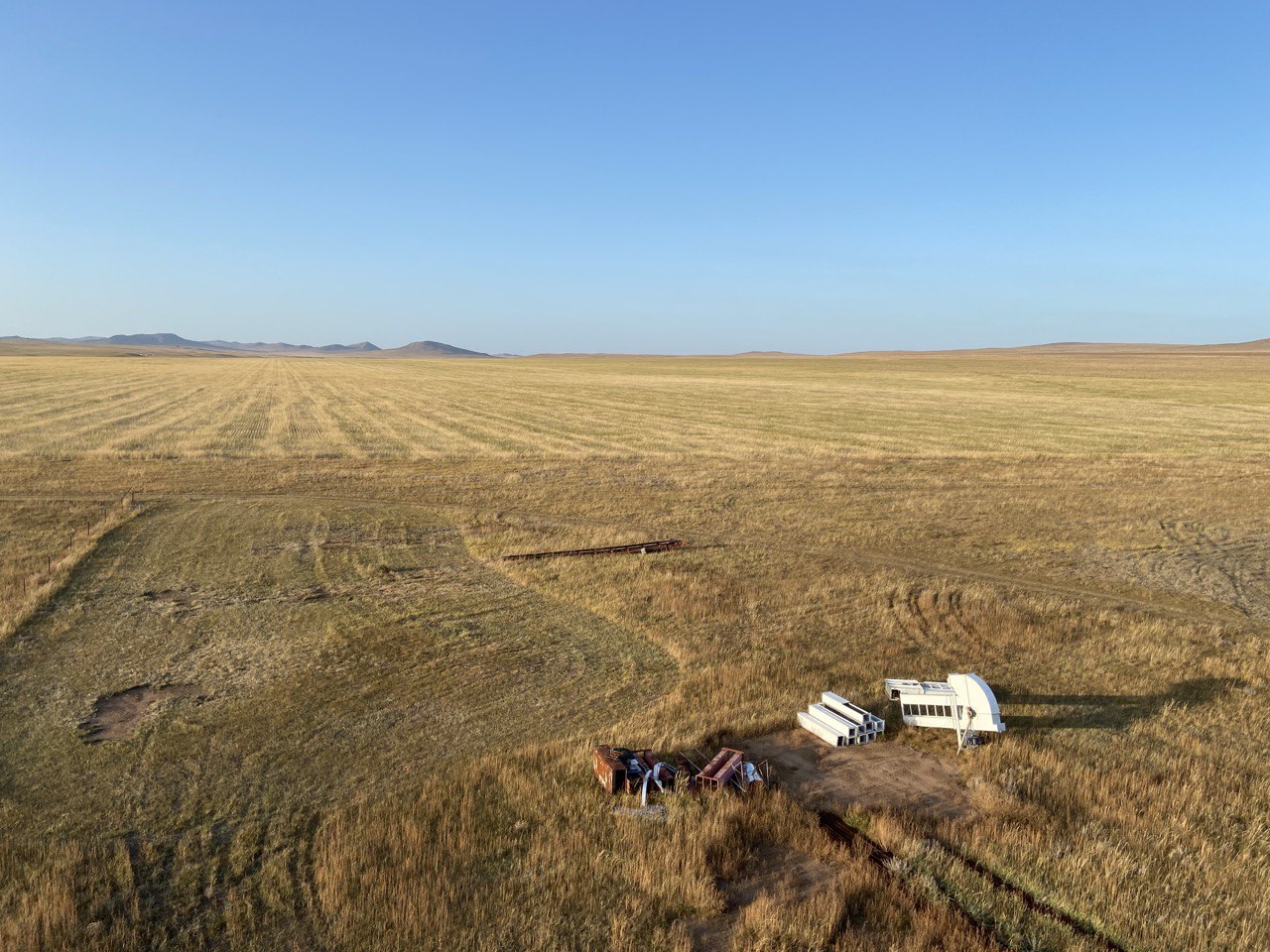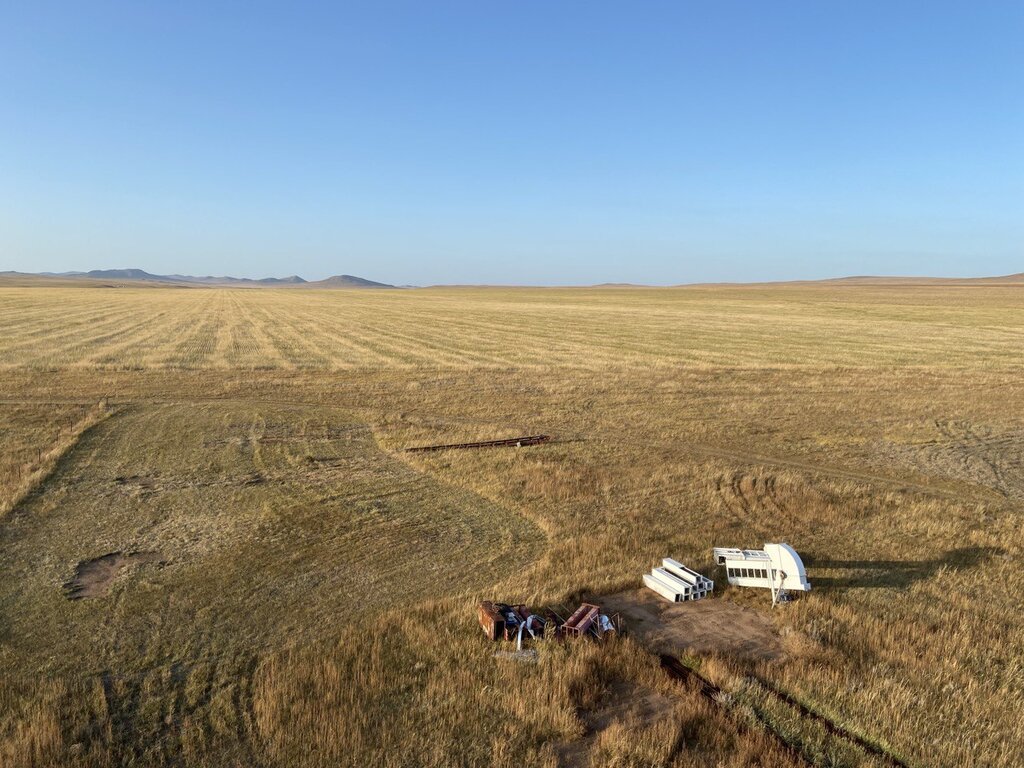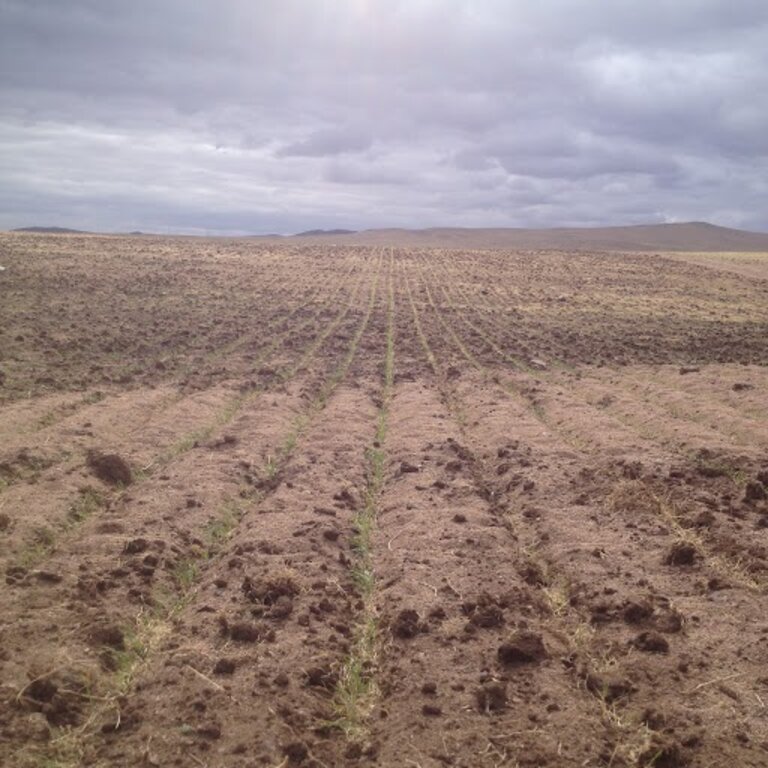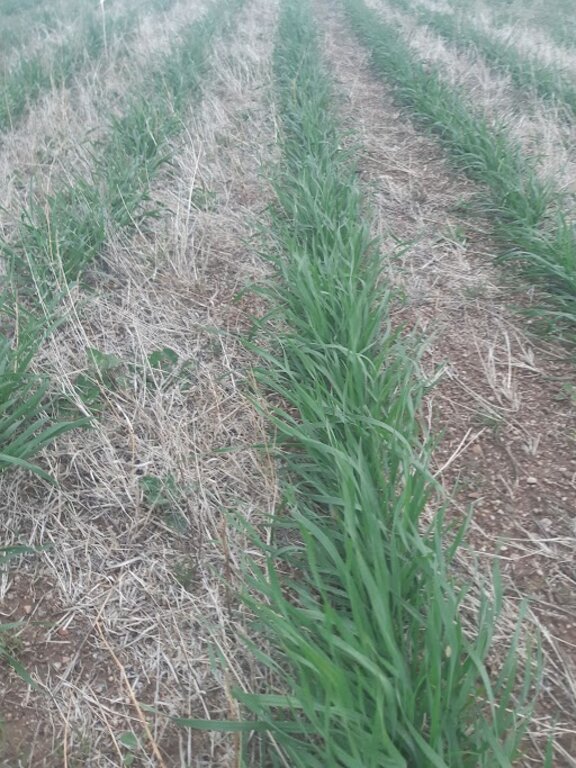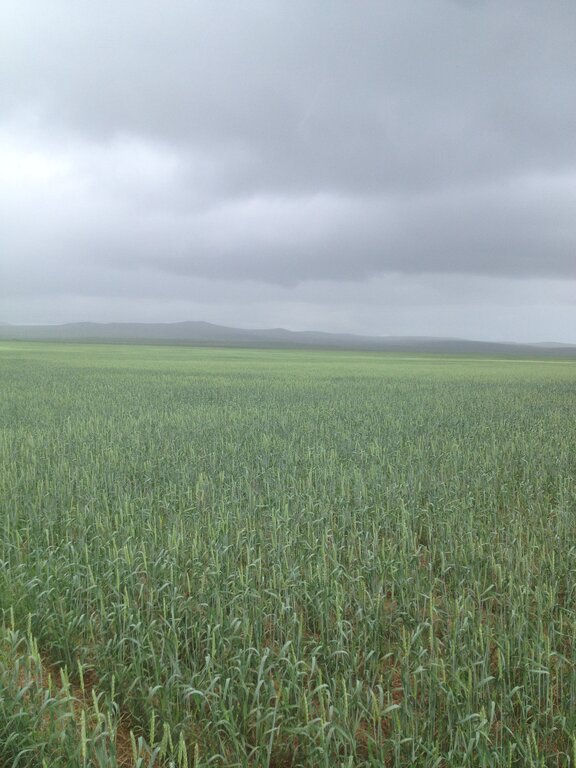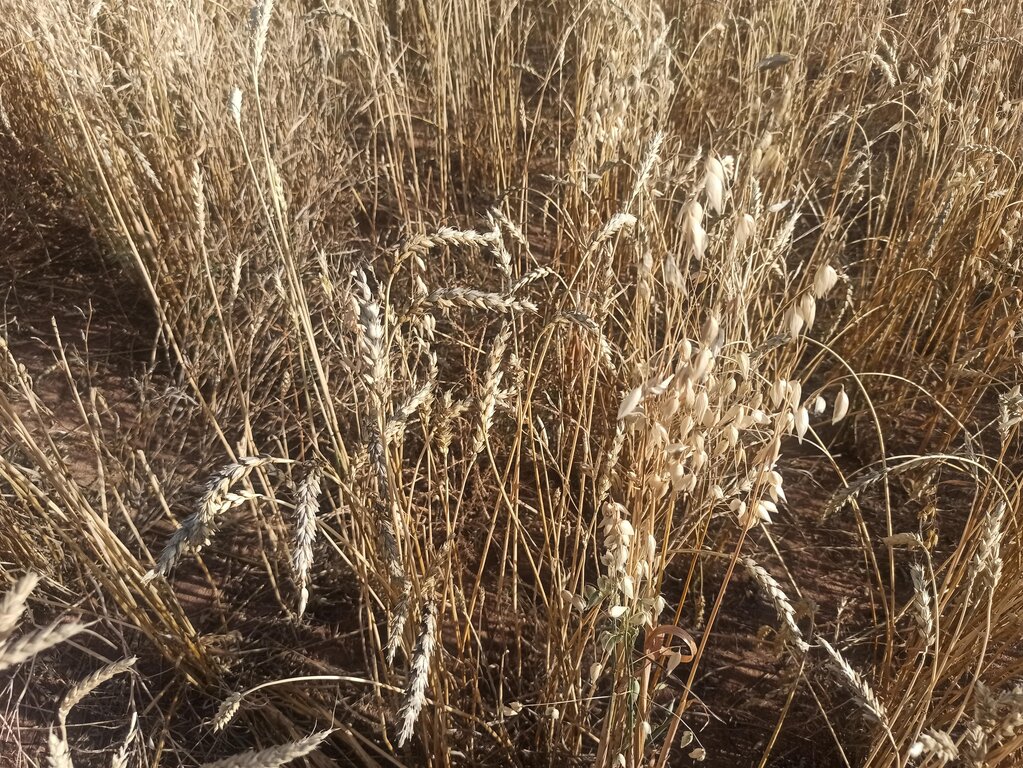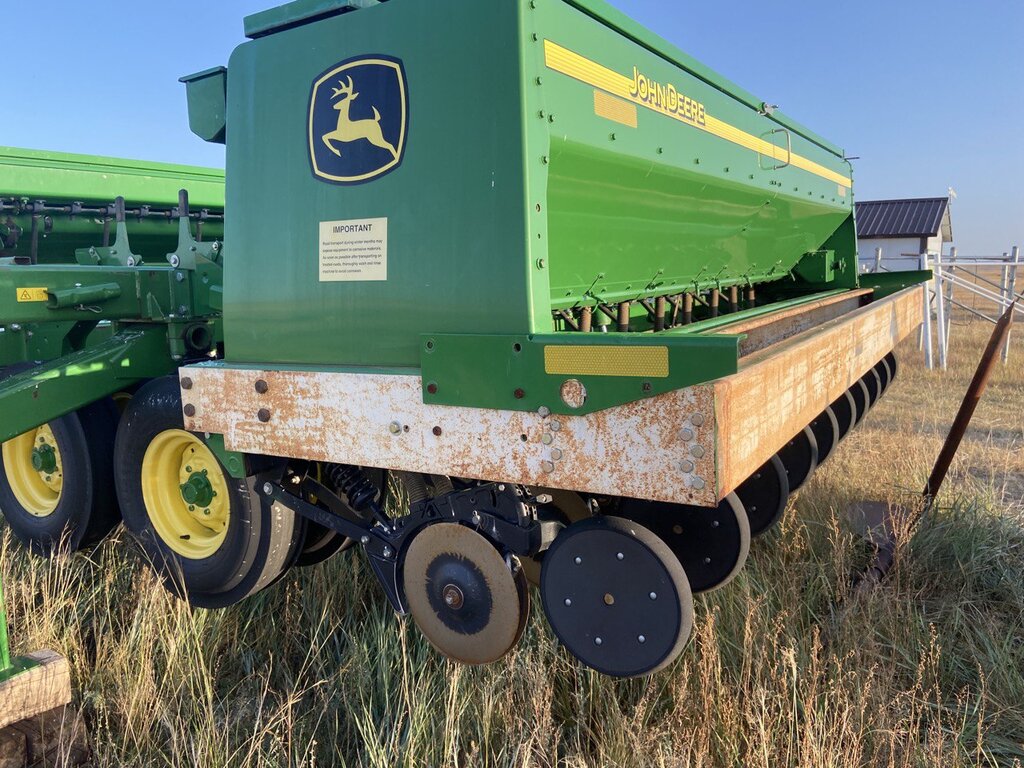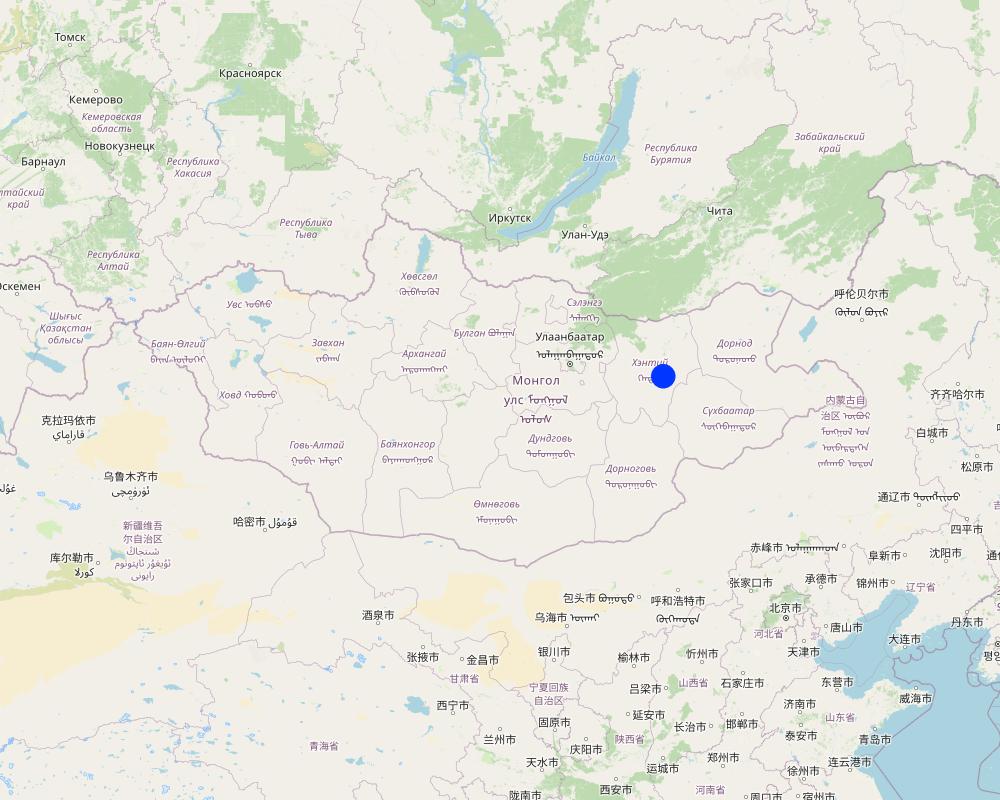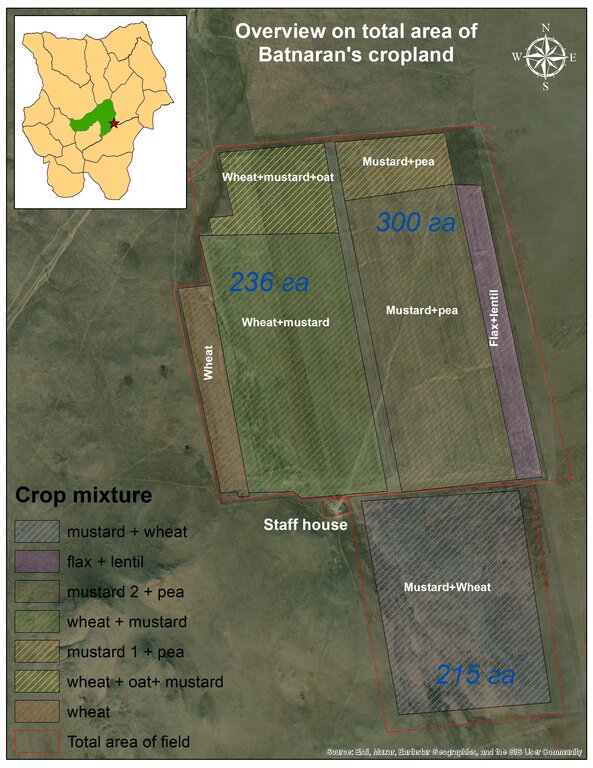Conservation agriculture to restore abandoned cropland [Mongolia]
- Creación:
- Actualización:
- Compilador: Otgontsetseg Davaanyam
- Editor: Mandakh Nyamtseren
- Revisor: Rima Mekdaschi Studer
Khurs Khamgaalliin gazar tarialan
technologies_6938 - Mongolia
Visualizar secciones
Expandir todo Colapsar todos1. Información general
1.2 Detalles de contacto de las personas de referencia e instituciones involucradas en la evaluación y la documentación de la Tecnología
Persona(s) de referencia clave
usuario de la tierra:
Batdeleg Batnaran
Khentiin Tarialan LLC
Mongolia
Nombre del proyecto que financió la documentación/ evaluación de la Tecnología (si fuera relevante)
Decision Support for Mainstreaming and Scaling out Sustainable Land Management (GEF-FAO / DS-SLM)Nombre de la(s) institución(es) que facilitaron la documentación/ evaluación de la Tecnología (si fuera relevante)
Mongolian Academy of Sciences, Institute of Geography and Geoecology (IGG) - Mongolia1.3 Condiciones referidas al uso de datos documentados mediante WOCAT
El compilador y la/s persona(s) de referencia claves aceptan las condiciones acerca del uso de los datos documentados mediante WOCAT:
Sí
1.4 Declaración de la sostenibilidad de la Tecnología descrita
¿La Tecnología aquí descrita resulta problemática en relación a la degradación de la tierra, de tal forma que no puede considerársela una tecnología sostenible para el manejo de la tierra?
No
Comentarios:
This technology is a SLM technology, because it returned abandoned land to productive agricultural land while building up soil health.
1.5 Referencia al (los) Cuestionario(s) de Enfoques MST (documentados usando WOCAT)
2. Descripción de la Tecnología MST
2.1 Breve descripción de la Tecnología
Definición de la Tecnología:
This technology aimed to restore abandoned cropland which was used for crop and fodder production during the 1970s-1980s. Since 2016, the farmer applied conservation agriculture and mixed cropping to reduce land degradation, revive cropping practices, increase land productivity for agriculture and enhance soil health.
2.2 Descripción detallada de la Tecnología
Descripción:
The land in Kherlen soum, Khentii province, spanning 500 hectares, was used for crop production and later for producing fodder for livestock. However, since 1984, it has been left abandoned. To rehabilitate the area and revive cropland, conservation agriculture combined with mixed cropping was introduced in 2014.
Mixed cropping encompasses various agrotechnical practices that involve the cultivation of different crops together, making use of their ability to interact with each other. The aim is to sustain crop yield in regions with limited moisture, protect the soil surface, regulate soil moisture levels, and enhance the availability of micro and macro-nutrients. In Kherlen soum, Khentii province, mixed cropping was implemented by planting seed mixtures of different proportions, taking into consideration the specific requirements and differences among various crops. Presently, annual crops such as mustard, peas, Cape rice, and wheat, rye along with rapeseeds, are successfully cultivated mixed and/or in rotation in the area.
Conservation agriculture in soil protection agriculture offers several advantages, including the enhancement of soil, its resilience to external factors such as erosion by wind, regulation of soil fertility and microorganism populations, avoidance of highly toxic substances in agriculture, and increased productivity. One significant aspect of conservation agriculture is using no-till and direct sowing techniques to minimize soil disturbance. During harvesting, only the crop heads are collected, while the remaining rootsystems and stems are left in and above the soil contributing to increasing soil organic matter. Other residues and parts of plants, such as straw/ stalks and leaves, are shredded and spread across the field to reduce soil moisture evaporation and protect it from the sun and wind. Soil erosion by wind can be mitigated by covering the soil as much and long as possible either by leaving the crop residues on the soil and/or including cover crops into crop rotations. Furthermore, this technology improves the soil health and microenvironment/ microclimate.
To initiate and implement this technology, the land user leased most of his land through a proposal, aimed at improving the soil quality of abandoned land, to the local government, and also purchased a certain amount of land through a land auction announced on the government website. Initial preparation of land for sowing consisted of removing stones from the field and spraying herbicides to get rid of weeds and their seeds. A minimal dose of herbicides with low toxicity is used to control the growth and spread of weed plants commonly found in abandoned fields. Later on mustard was incorporated into mixed cropping and rotations suppressing the growth of weed.
In the first year, the farmer planted a mixture of mustard, oilseed rape and lucerne to enhance soil penetration and break up compacted soil, as well as wheat in a 40 cm strip on stony soil with low fertility. First few years 2014-2018), the farmer didn’t harvest all the yields to keep the soil covered and improve the soil quality.
In 2019 the farmer built a fence to protect against grazing and yields significantly improved. Moreover, various equipment such as direct seeder for no till or minimum tillage crop cultivation, combine harvester, tractor, herbicide spraying machine and seed sorting machines to improve the quality of produce for the market (clean and separate seeds of different sizes and different types of crops) were bought with a bank loan.
A comprehensive knowledge of the interactions and symbiotic relationships between different crops is also essential to plan for crop mixtures and rotations. Crop morphology such as root system, competition for nutrients and water should be considered. Mustard-pea mixture facilitates harvesting as pea is difficult to harvest in monoculture and mustard can provide biological weed control.
He divided the land / field into 12 plots, which were planted with different crop mixtures and in rotation, maintaining soil fertility, limiting pests and diseases, and increasing crop yields. Legumes can improve soil fertility by adding nitrogen to the soil. The farmer practiced five-field rotation in his cropland using legumes including pea, bean, lentils and alfalfa. The rotation plan depends on climate conditions.
The levels of potassium and phosphorous in the soil were monitored and regularly measured. Only when a deficit occurred the land user used mineral fertilizers.
According to farmers who practice conservation agriculture and mixed farming, these technologies effectively maintains soil stability, ensuring its long-term sustainability.
2.3 Fotografías de la Tecnología
2.5 País/ región/ lugares donde la Tecnología fue aplicada y que se hallan comprendidos por esta evaluación
País:
Mongolia
Región/ Estado/ Provincia:
Khentii province
Especifique más el lugar :
Kherlen soum, Takhilgat bag
Especifique la difusión de la Tecnología:
- distribuida parejamente sobre un área
Si la Tecnología se halla difundida homogéneamente a lo largo de un área, especifique el área que cubre (en km2):
8,0
Si se desconoce el área precisa, indique el área aproximada cubierta:
- 1-10 km2
¿El/los sitio(s) de la Tecnología se ubica(n) en un área de protección permanente?
No
Comentarios:
The area is not a part of the permanently protected area.
Map
×2.6 Fecha de la implementación
Indique año de implementación:
2014
Si no se conoce el año preciso, indique la fecha aproximada:
- hace menos de 10 años (recientemente)
2.7 Introducción de la Tecnología
Especifique cómo se introdujo la Tecnología:
- mediante la innovación de usuarios de tierras
- durante experimentos/ investigación
Comentarios (tipo de proyecto, etc.):
The farmer planted mustard, rapeseed, and alfalfa in rotation and mixture based on national and international experiences and research on conservation agriculture. These plants have taproot systems that penetrate the soil, enhance water uptake from lower soil depth and make the hardpan soil more porous. After implementing this technology, the land user observed and monitored the field himself. He observed that the retention of soil moisture has increased, soil erosion has significantly decreased, and biological diversity, including microorganisms, insects, and birds, has also increased due to the presence of cover plants.
3. Clasificación de la Tecnología MST
3.1 Propósito(s) principal(es) de la Tecnología MST
- mejorar la producción
- reducir, prevenir, restaurar la degradación del suelo
- preservar/ mejorar biodiversidad
- adaptarse al cambio climático/ extremos climáticos y sus impactos
- crear impacto económico benéfico
3.2 Tipo(s) actuales de uso de la tierra donde se aplica la Tecnología
Mezcla de tipos de uso de tierras dentro de la misma unidad de tierras: :
No

Tierras cultivadas
- Cosecha anual
Cosechas anuales - Especifique cultivos:
- cereales - cebada
- cereales - avena
- cereales - trigo (verano)
- cultivos para producción de fibras - lino, cáñamo, otros
- cultivos para forraje - alfalfa
- legumes and pulses - lentils
- leguminosas y legumbres - arvejas
- cultivos de semillas oleaginosas - girasol, colza, otros
- cultivos de semillas - sésamo, amapola, mostaza, otros
Sistema anual de cultivo:
Trigo o rotación similar con heno/pastizal
Número de temporadas de cultivo por año:
- 1
Especifique:
Plant seeds are sown in April and harvested in August to September.
¿Se practica el intercultivo?
No
¿Se practica la rotación de cultivos?
Sí
Si fuera el caso, especifique :
Entire field/ area was divided into 5 main sections, allowing to practice crop rotation. In general, a rotation consists of cereal crops follow by broad leaved crops. Within one plot, the land user decides the mixture of crop depending on the weather condition in the year. If a mixture of mustard-wheat was planted in this year, another crop mixture should be planted in the next year.
3.3 ¿Cambió el uso de tierras debido a la implementación de la Tecnología?
¿Cambió el uso de tierras debido a la implementación de la Tecnología?
- Sí (Por favor responda las preguntas de abajo referidas al uso de la tierra antes de implementar la Tecnología)
Mezcla de tipos de uso de tierras dentro de la misma unidad de tierras: :
No

Tierra no productiva
Especifique:
Abandoned land
Comentarios:
Monoculture crops were planted in the area during the socialist period, and it was left unused and abandoned since 1986. Therefore, the productivity and fertility of the land decreased.
3.4 Provisión de agua
Provisión de agua para la tierra donde se aplica la Tecnología:
- de secano
Comentarios:
Irrigation systems are not used throughout the field.
3.5 Grupo MST al que pertenece la Tecnología
- sistemas de rotación (rotación de cosecha, cosecha rotatoria con descanso, agricultura migratoria)
- cobertura de suelo/ vegetal mejorada
- perturbación mínima del suelo
3.6 Medidas MST que componen la Tecnología

medidas agronómicas
- A1: vegetación/ cubierta del suelo
- A2: materia orgánica/ fertilidad del suelo
- A3: Tratamiento de superficie del suelo
- A5: Manejo de semillas, variedades mejoradas
- A6: Manejo de residuos
A3: Diferencie sistemas de labranza:
A 3.1: Sin labranza
A6: Especifique manejo de residuos:
A 6.4: retenido

medidas de manejo
- M1: Cambio de tipo de uso de la tierra
Comentarios:
Abandoned land had been converted into annual cropland. According to the classification of Mongolian Land Unified Fund, land was classified as abandoned land and changed into agricultural land after starting to use it.
3.7 Principales tipos de degradación del suelo encarados con la Tecnología

erosión de suelos por viento
- Et: pérdida de capa arable
- Eo; efectos de degradación fuera del sitio:

deterioro químico del suelo
- Cn: reducción de la fertilidad y contenido reducido de la materia orgánica del suelo (no ocasionados por la erosión)

degradación biológica
- Bc: reducción de la cobertura vegetal del suelo
- Bq: reducción de la cantidad/ biomasa
- Bs: reducción en la calidad y composición/ diversidad de las especies
Comentarios:
The soil in the abandoned land became infertile due to water and wind erosion, and thus, there had been a decrease in biodiversity in the soil as well as in plant diversity and productivity.
3.8 Prevención, reducción o restauración de la degradación del suelo
Especifique la meta de la Tecnología con relación a la degradación de la tierra:
- restaurar/ rehabilitar tierra severamente degradada
Comentarios:
The technology aims to revive the agricultural practice in abandoned cropland, protect the soil from erosion, enhance its moisture and organic matter, and improve biological diversity by planting a variety of plants, thereby allowing opportunities for long-term sustainable use.
4. Especificaciones técnicas, actividades de implementación, insumos y costos
4.1 Dibujo técnico de la Tecnología
Especificaciones técnicas (relacionadas al dibujo técnico):
This diagram shows how the crop mix was distributed across the field in 2023 (on different plots). Entire field was divided into 5 main sections which are intended for crop rotation and also several small sections which are for ensuring seed source. More than 20 types of crops were planted in the whole field. A five-field rotation is practiced in this cropland with a sequence of cereal grains (wheat, barley, oats, etc.) followed by leafy plants (flax, lentils, peas, mustard, etc.), depending on the climatic conditions of the year. In dry years, the land user prefers to grow cereals and flax, which are more resistant to drought, and then rotate cereals with a mixture of leafy plants the following year. In years with good humidity, on the other hand, a mixture of mustard + peas + oats + lentils is suitable. The advantages of this mixture is to improve soil fertility and to control diseases and pest. In addition, soil remains covered against soil erosion. Inclusion of different crops means also increase in agrobiodiversity.
Autor:
Ankhbayar N., Gereltuya G.
Fecha:
02/10/2023
4.2 Información general sobre el cálculo de insumos y costos
Especifique cómo se calcularon los costos e insumos:
- por área de Tecnología
Indique tamaño y unidad de área:
800 ha
otra / moneda nacional (especifique):
Tugrik
Si fuera relevante, indique la tasa de cambio de dólares americanos a la moneda local (ej. 1 U$ = 79.9 Reales Brasileros): 1 U$ =:
3453,0
Indique el costo promedio del salario de trabajo contratado por día:
50000 - 100000 Tugrik
4.3 Actividades de establecimiento
| Actividad | Momento (estación) | |
|---|---|---|
| 1. | Build fence | before sowing |
| 2. | Prepare (picking stones) and plough land | before sowing |
| 3. | Buy and spray herbicide | before sowing |
| 4. | Purchase tractor | before sowing |
| 5. | Purchase direct seeder | before sowing |
| 6. | Purchase combine harvester | before sowing |
| 7. | Purchase spray machine | before sowing |
| 8. | Purchase seed cleaning machine | before sowing |
| 9. | Purchase stone picker machine | before sowing |
| 10. | Purchase or rent pile machine for fencing | before sowing |
| 11. | Purchase silos | before harvesting |
| 12. | Storage shed | before harvesting |
Comentarios:
Establishing a fence before the technology is an essential activity to protect from grazing and retain cover plants. The farmer empahsized that it is important to choose materials with good quality for building fence. He used imported fencing material from Canada of which the price was higher than average local market price.
4.4 Costos e insumos necesarios para el establecimiento
| Especifique insumo | Unidad | Cantidad | Costos por unidad | Costos totales por insumo | % de los costos cubiertos por los usuarios de las tierras | |
|---|---|---|---|---|---|---|
| Mano de obra | Build fence | person | 2,0 | 15000000,0 | 30000000,0 | 100,0 |
| Mano de obra | Spray herbicide | person | 2,0 | 350000,0 | 700000,0 | 100,0 |
| Mano de obra | Sowing | person | 1,0 | 4000000,0 | 4000000,0 | 100,0 |
| Mano de obra | Stone picking | person | 1,0 | 4800000,0 | 4800000,0 | 100,0 |
| Equipo | Tractor | piece | 1,0 | 220000000,0 | 220000000,0 | 100,0 |
| Equipo | Direct seeder | piece | 1,0 | 224000000,0 | 224000000,0 | 100,0 |
| Equipo | Combine harvester | piece | 2,0 | 397000000,0 | 794000000,0 | 100,0 |
| Equipo | Agriculture spray machine | piece | 1,0 | 170000000,0 | 170000000,0 | 100,0 |
| Equipo | Stone picker machine | piece | 1,0 | 15000000,0 | 15000000,0 | 100,0 |
| Equipo | Seed cleaning machine | piece | 3,0 | 35000000,0 | 105000000,0 | 100,0 |
| Equipo | Pile machine for fencing | piece | 1,0 | 6900000,0 | 6900000,0 | 100,0 |
| Equipo | Silos | tonnes (holding capacity) | 700,0 | 714285,72 | 500000004,0 | 100,0 |
| Material para plantas | Seeds first year | tonnes | 70,5 | 4400000,0 | 310200000,0 | 100,0 |
| Fertilizantes y biocidas | Herbicide | l | 2400,0 | 8000,0 | 19200000,0 | 100,0 |
| Material de construcción | Poles and net for fence | km | 25,0 | 10800000,0 | 270000000,0 | 100,0 |
| Otros | Land lease | ha | 800,0 | 500000,0 | 400000000,0 | 100,0 |
| Costos totales para establecer la Tecnología | 3073800004,0 | |||||
| Costos totales para establecer la Tecnología en USD | 890182,45 | |||||
Comentarios:
The implementation of conservation agriculture and mixed cropping was self-funded by land user. For certain initial investments he took a loan from the bank. The fence materials were imported from Canada, for its good quality.
4.5 Actividades de establecimiento/ recurrentes
| Actividad | Momento/ frequencia | |
|---|---|---|
| 1. | Sowing/ direct seeding | April to May per year |
| 2. | Harvesting and separating harvested seeds | once in August to September |
| 3. | Reproducing seed for own use and sowing | after harvest |
| 4. | Spray herbicide | if necessary, once in 2-3 year |
| 5. | Monitoring on plant development (e.g. germination, flowering, maturity) | at each plant development stage |
| 6. | Monitoring soil fertility | once a year, in August |
Comentarios:
Soil samples are taken and sent to a specialized laboratory for analysis.
4.6 Costos e insumos necesarios para actividades de mantenimiento/ recurrentes (por año)
| Especifique insumo | Unidad | Cantidad | Costos por unidad | Costos totales por insumo | % de los costos cubiertos por los usuarios de las tierras | |
|---|---|---|---|---|---|---|
| Mano de obra | Spray herbicide | person | 2,0 | 1400000,0 | 2800000,0 | 100,0 |
| Mano de obra | Harvesting | person | 4,0 | 1500000,0 | 6000000,0 | 100,0 |
| Mano de obra | Separating seeds | person | 2,0 | 1000000,0 | 2000000,0 | 100,0 |
| Mano de obra | Sowing seeds | person | 2,0 | 1500000,0 | 3000000,0 | 100,0 |
| Equipo | Spare parts and maintenance of machines | ha | 800,0 | 10500,0 | 8400000,0 | 100,0 |
| Equipo | Spraying machine (fuel) | l/year | 400,0 | 2400,0 | 960000,0 | 100,0 |
| Equipo | Sowing machine (fuel) | l/year | 4000,0 | 2400,0 | 9600000,0 | 100,0 |
| Equipo | Combine harvesting machine (fuel) | l/year | 4000,0 | 2400,0 | 9600000,0 | 100,0 |
| Material para plantas | Seeds | tonne/year | 13,7 | 4400000,0 | 60280000,0 | 100,0 |
| Fertilizantes y biocidas | Herbicide (different types) | l | 1,0 | 30000,0 | 30000,0 | 100,0 |
| Otros | Land use tax | MNT/year | 1,0 | 1900000,0 | 1900000,0 | 100,0 |
| Otros | Soil sampling and testing | MNT/year | 1,0 | 830000,0 | 830000,0 | 100,0 |
| Indique los costos totales para mantenecer la Tecnología | 105400000,0 | |||||
| Costos totales para mantener la Tecnología en USD | 30524,18 | |||||
Comentarios:
The amount of herbicide used in a given year depends on the type of weed and its distribution. Initially, the land user spent 19 million (2400 litres) on herbicide to prepare the field for cultivation, and the price was relatively low compared to today (8000 MNT on average). But, in 2022, different types of herbicides were bought for different types of weeds distributed in the field and 120 million MNT (1800 litres) were spent because the price became high compared to other years due to the border closure (COVID). But in 2023, only 30 000 MNT (1 litre) was spent on herbicides in the whole field.
The land user and a permanent help receive a monthly salary.
4.7 Factores más determinantes que afectan los costos:
Describa los factores más determinantes que afectan los costos:
Factors that mainly affect the cost are inflation and the MNT exchange rate (mainly relevant when purchasing imported products). In addition, in the event of extreme weather and disastrous conditions, extra labor may be required to mitigate damage.
5. Entorno natural y humano
5.1 Clima
Lluvia anual
- < 250 mm
- 251-500 mm
- 501-750 mm
- 751-1,000 mm
- 1,001-1,500 mm
- 1,501-2,000 mm
- 2,001-3,000 mm
- 3,001-4,000 mm
- > 4,000 mm
Especifique el promedio anual de lluvia (si lo conoce), en mm:
150,00
Indique el nombre de la estación metereológica de referencia considerada:
Undurkhaan
Zona agroclimática
- semi-árida
This region includes a region with harsh cold winters and dry summers. The average annual air temperature is -0.2 celsius, and the difference between day and night temperature ranges from 13 to 15 degrees.
5.2 Topografía
Pendientes en promedio:
- plana (0-2 %)
- ligera (3-5%)
- moderada (6-10%)
- ondulada (11-15%)
- accidentada (16-30%)
- empinada (31-60%)
- muy empinada (>60%)
Formaciones telúricas:
- meseta/ planicies
- cordilleras
- laderas montañosas
- laderas de cerro
- pies de monte
- fondo del valle
Zona altitudinal:
- 0-100 m s.n.m.
- 101-500 m s.n.m.
- 501-1,000 m s.n.m
- 1,001-1,500 m s.n.m
- 1,501-2,000 m s.n.m
- 2,001-2,500 m s.n.m
- 2,501-3,000 m s.n.m
- 3,001-4,000 m s.n.m
- > 4,000 m s.n.m
Indique si la Tecnología se aplica específicamente en:
- situaciones cóncavas
5.3 Suelos
Profundidad promedio del suelo:
- muy superficial (0-20 cm)
- superficial (21-50 cm)
- moderadamente profunda (51-80 cm)
- profunda (81-120 cm)
- muy profunda (>120 cm)
Textura del suelo (capa arable):
- áspera/ ligera (arenosa)
Textura del suelo (> 20 cm debajo de la superficie):
- mediana (limosa)
Materia orgánica de capa arable:
- baja (<1%)
5.4 Disponibilidad y calidad de agua
Agua subterránea:
5-50 m
Disponibilidad de aguas superficiales:
bueno
Calidad de agua (sin tratar):
agua potable de buena calidad
La calidad de agua se refiere a:
agua subterránea y superficial
¿La salinidad del agua es un problema?
No
¿Se está llevando a cabo la inundación del área? :
Sí
Frecuencia:
frecuentemente
Comentarios y especificaciones adicionales sobre calidad y cantidad de agua:
It depends on intensity of rainfall.
5.5 Biodiversidad
Diversidad de especies:
- mediana
Diversidad de hábitats:
- baja
Comentarios y especificaciones adicionales sobre biodiversidad:
Based on an animal and plant richness research study, biodiversity in this region is classified as moderate. After the implementation of the technology, more species of insects and birds were found in the fields due to the increase in agrobiodiversity.
5.6 Las características de los usuarios de la tierra que aplican la Tecnología
Sedentario o nómada:
- Sedentario
Orientación del mercado del sistema de producción:
- comercial/ mercado
Ingresos no agrarios:
- menos del 10% de todos los ingresos
Nivel relativo de riqueza:
- promedio
Individuos o grupos:
- empleado (compañía, gobierno)
Nivel de mecanización:
- mecanizado/motorizado
Género:
- hombres
Edad de los usuarios de la tierra:
- personas de mediana edad
Indique otras características relevantes de los usuarios de las tierras:
Khentiin Tarialan LLC is a company with theland user and an aid are employed and with seasonally hired labour.
5.7 Área promedio de la tierra usada por usuarios de tierra que aplican la Tecnología
- < 0.5 ha
- 0.5-1 ha
- 1-2 ha
- 2-5 ha
- 5-15 ha
- 15-50 ha
- 50-100 ha
- 100-500 ha
- 500-1,000 ha
- 1,000-10,000 ha
- > 10,000 ha
¿Esto se considera de pequeña, mediana o gran escala (refiriéndose al contexto local)?
- escala mediana
Comentarios:
Based on standards, the area used by the land user is considered to be a medium-scale.
5.8 Tenencia de tierra, uso de tierra y derechos de uso de agua
Tenencia de tierra:
- estado
Derechos de uso de tierra:
- arrendamiento
Derechos de uso de agua:
- individual
¿Los derechos del uso de la tierra se basan en un sistema legal tradicional?
No
Comentarios:
Land is rented for a period of 15 years and when duration is over, the contract can be extended. Land users pay land use tax every year. Land use rights for agricultural production was leased by auction.
5.9 Acceso a servicios e infraestructura
salud:
- pobre
- moderado
- bueno
educación:
- pobre
- moderado
- bueno
asistencia técnica:
- pobre
- moderado
- bueno
empleo (ej. fuera de la granja):
- pobre
- moderado
- bueno
mercados:
- pobre
- moderado
- bueno
energía:
- pobre
- moderado
- bueno
caminos y transporte:
- pobre
- moderado
- bueno
agua potable y saneamiento:
- pobre
- moderado
- bueno
servicios financieros:
- pobre
- moderado
- bueno
6. Impactos y comentarios para concluir
6.1 Impactos in situ demostrados por la Tecnología
Impactos socioeconómicos
Producción
producción de cultivo
Cantidad antes de MST:
0
Cantidad luego de MST:
25 centner/ha
Comentarios/ especifique:
It is important to note that crop production is highly dependent on weather conditions. In 2021, when there was enough precipitation, a yield of 25 centner/ha was achieved. However, in 2014-2016, when technology implementation was just starting in severely degraded land and coincided with drought, there were occasions where all yield was lost.
calidad de cultivo
Comentarios/ especifique:
Specific weight, indicating seed quality, of grain reached 900 g/l and, gluten content of wheat always meets the requirements of first grade of food.
producción de forraje
Comentarios/ especifique:
Comparisons between 2018 and 2022 indicate that the average length of the wheat grain head increased and reached 10 - 12 centimeters by 1st July, resulting in a higher yield. Oats and wheat are harvested for fodder production while peas are supplied to chicken farms.
calidad de forraje
Comentarios/ especifique:
In terms of wheat quality, it is classified into first grade. The protein content of Bayalag variety of peas is 18-20%, starch content is 26-35%.
riesgo de fracaso de producción
Comentarios/ especifique:
We concluded that this technology can overcome any risks related to labor and expenses, because sowing time is different for many types of crops, reducing the amount of expenses and labor load.
diversidad de producto
Cantidad antes de MST:
1
Cantidad luego de MST:
20
Comentarios/ especifique:
About 20 species of plants are being cultivated.
Ingreso y costos
gastos en insumos agrícolas
Cantidad antes de MST:
9 centner
Cantidad luego de MST:
3 centner
Comentarios/ especifique:
The amount of seeds used for planting is lower, the seeds can be used for the next year cultivation: The spread of plant diseases / pests and use of pesticides is relatively low. Herbizides and fertilizers are not applied in this technology. Thus, there is no expense on that.
ingreso agrario
Cantidad luego de MST:
5 centner
Comentarios/ especifique:
The yield is dependent on the climatic conditions of the year. In wheat yield, 3 centners were spent on sowing and 5 centners were obtained for each hectare when the weather was not favorable and precipitation was relatively low. Therefore, the net income is 2 centners in this case.
carga de trabajo
Cantidad antes de MST:
4
Cantidad luego de MST:
2
Comentarios/ especifique:
Sowing time is different for many types of crops, so it does not requires a high number of labor. 2 persons typically work on the entire area throughout the year and, 2 more persons are employed during harvesting.
Impactos socioculturales
seguridad alimentaria/ autosuficiencia
MST/ conocimiento de la degradación del suelo
Comentarios/ especifique:
Mentorship program for other farmers is organized.
Impactos ecológicos
Ciclo de agua/ escurrimiento de sedimento
evaporación
Comentarios/ especifique:
Due to cover crops and residue left on the soil, it reduces the amount of water evaporation from the soil and keeps the soil moisture .
Suelo
humedad del suelo
Comentarios/ especifique:
Cover crops and plant residues left on the soil surface protect against wind erosion, reduces soil water evaporation and improves soil moisture content.
cubierta del suelo
Cantidad antes de MST:
0 cm
Cantidad luego de MST:
2 cm
Comentarios/ especifique:
Before the technology was introduced, the field was barely covered with plants and the topsoil had been severely eroded by the wind, resulting in a loss of fertility and covered with gravel.
pérdida de suelo
Comentarios/ especifique:
Snow cover in winter, has an important effect on protecting the soil from wind erosion in the spring.
ciclo/ recarga de nutrientes
materia orgánica debajo del suelo C
Comentarios/ especifique:
It is believed that when the content of organic matter in the soil increases by 1 percent, the water holding capacity of the soil increases by 4 percent. From this point of view, it can be concluded that the content of organic matter has improved.
Biodiversidad: vegetación, animales
Cubierta vegetal
Comentarios/ especifique:
Before the technology, vegetation cover was sparse and there were only 2-3 species of weeds in a square of 1m x 1m.
biomasa/ sobre suelo C
Comentarios/ especifique:
Aboveground biomass increased. Prairie sagebrush is predominating in natural vegetation community.
diversidad vegetal
diversidad animal
Comentarios/ especifique:
According to the results of soil sampling, the ratio of microorganisms in the soil has increased. It is also clearly observed that the variety of insects and the birds that feed on them have increased due to the rise in plant species.
especies benéficas
Comentarios/ especifique:
From 2019, mushrooms started growing in the field. Flaxes, forming symbioses with fungus, are planted in order to enhance distribution of fungus in soil. Fungus has a positive effect on soil quality.
control de pestes/ enfermedades
Comentarios/ especifique:
Mustard and peas have been observed to limit the growth of weeds such as hogweed. Additionally, mustard releases two powerful substances that can help limit the spread of diseases.
Reducción de riesgos de desastres y riesgos climáticos
impactos de inundaciones
Cantidad antes de MST:
high
Cantidad luego de MST:
low
Comentarios/ especifique:
Sown stands and plant cover can mitigate heavy flooding, then, the risk of washing away the fertile layer of the soil can be reduced. In addition, the stands will retain plant residues and other objects carried by the flood water. It can also be composted into the soil.
impactos de sequías
Cantidad antes de MST:
high
Cantidad luego de MST:
low
Comentarios/ especifique:
Because the soil moisture content is good compared to other areas, the yield is higher in drought years and soil erosion is less.
velocidad de viento
Comentarios/ especifique:
Wind velocity is high in this region. We are thinking about establishing windbreak in the field.
Especifique la evaluación de los impactos en el sitio (mediciones):
In winter, vertical stems of plants hold snow well. It has an important effect on soil protection and increasing soil moisture in spring.
6.2 Impactos fuera del sitio demostrados por la Tecnología
sedimentos transportados por el viento
Comentarios/ especifique:
Improves wind cleanliness by catching organic material and other residues carried by the wind.
daño a campos de vecinos
Comentarios/ especifique:
The technology can reduce the risk of flooding
Especifique la evaluación de los impactos fuera del emplazamiento (medidas):
The land user, implementing the technology, made a conclusion based on his own observations.
6.3 Exposición y sensibilidad de la Tecnología al cambio climático gradual y a extremos relacionados al clima/ desastres (desde la percepción de los usuarios de tierras)
Cambio climático gradual
Cambio climático gradual
| Estación | Incremento o reducción | ¿Cómo es que la tecnología soporta esto? | |
|---|---|---|---|
| temperatura anual | incrementó | bien | |
| temperatura estacional | verano | incrementó | moderadamente |
| temperatura estacional | invierno | disminuyó | no muy bien |
| lluvia estacional | verano | disminuyó | no muy bien |
| lluvia estacional | primavera | disminuyó | moderadamente |
Extremos (desastres) relacionados al clima
Desastres climatológicos:
| ¿Cómo es que la tecnología soporta esto? | |
|---|---|
| tormenta de nieve local | moderadamente |
| tormenta de arena/ de polvo local | no muy bien |
Desastres climatológicos
| ¿Cómo es que la tecnología soporta esto? | |
|---|---|
| ola de calor | muy bien |
| sequía | muy bien |
Desastres biológicos
| ¿Cómo es que la tecnología soporta esto? | |
|---|---|
| enfermedades epidémicas | bien |
Otras consecuencias relacionadas al clima
Otras consecuencias relacionadas al clima
| ¿Cómo es que la tecnología soporta esto? | |
|---|---|
| periodo reducido de crecimiento | no muy bien |
6.4 Análisis costo-beneficio
¿Cómo se comparan los beneficios con los costos de establecimiento (desde la perspectiva de los usuarios de tierra)?
Ingresos a corto plazo:
negativo
Ingresos a largo plazo:
positivo
¿Cómo se comparan los beneficios con los costos de mantenimiento/ recurrentes (desde la perspectiva de los usuarios de tierra)?
Ingresos a corto plazo:
ligeramente positivo
Ingresos a largo plazo:
positivo
Comentarios:
Establishment cost for 800 hectare of agricultural farm was approximately 3.6 billion MNT and there is no income in first several years. In long term, annual cost have decreased and, annual income became 320 million MNT, net income 128 million MNT. Thus, income can be positive in long term.
6.5 Adopción de la Tecnología
- casos individuales / experimentales
Si tiene la información disponible, cuantifique (número de hogares y/o área cubierta):
1 household
De todos quienes adoptaron la Tecnología, ¿cuántos lo hicieron espontáneamente, por ej. sin recibir nada de incentivos/ materiales:
- 91-100%
Comentarios:
All expenses were paid by own.
6.6 Adaptación
¿La tecnología fue modificada recientemente para adaptarse a las condiciones cambiantes?
Sí
Si fuera así, indique a qué condiciones cambiantes se adaptó:
- cambios climáticos / extremos
Especifique la adaptación de la Tecnología (diseño, material/ especies, etc.):
Crop rotation decisions are made based on spring weather conditions and soil moisture of the planting year. In some years, the crop rotation and mixture is not changed.
6.7 Fuerzas/ ventajas/ oportunidades de la Tecnología
| Fuerzas/ ventajas/ oportunidades desde la perspectiva del usuario de la tierra |
|---|
| The technology provides higher yields than traditional monoculture in climate condition in Mongolia. |
| The technology allows to plant crops early in spring, because soil moisture absorbed from winter snow provide convenient condition. |
| Soil erosion and sand accumulation have been significantly reduced. |
| Conservation agricuture can significantly improve the physical properties of soil, providing sustainable and ecological rehabilitation of abandoned land. |
| Over time, soil fertility should improve as a result of increased soil organic matter. |
| Fuerzas/ ventajas/ oportunidades desde la perspectiva del compilador o de otra persona de referencia clave |
|---|
| Abandoned land can be restored at the lowest cost. |
| Soil conservation technology was used without reducing the soil fertility as well as returning of abandoned land into use. |
| The use of machinery in medium-scale farming is advantageous because it reduces labor costs. |
| Planting with low seed rates increases the economic efficiency in the long term. |
6.8 Debilidades/ desventajas/ riesgos de la Tecnología y formas de sobreponerse a ellos
| Debilidades/ desventajas/ riesgos desde la perspectiva del usuario de la tierra | ¿Cómo sobreponerse a ellas? |
|---|---|
| Due to climate change and aridity, in some years, crop loss occurs during the planting and growing period. | Install irrigation system for seasonal irrigation or irrigation when needed. |
| When harvesting, it is necessary to leave a plant cover as high as possible, which requires particular harvesting machine. | A combine harvester or a machine (head stripper) that collects only heads of the crop is required. |
| Debilidades/ desventajas/ riesgos desde la perspectiva del compilador o de otra persona de referencia clave | ¿Cómo sobreponerse a ellas? |
|---|---|
| The use of imported seeds increases the cost. | To cultivate crop seeds in small isolated areas. |
| With climate change, the lack of irrigation facilities increases risk of production failure. | More water harvesting techniiques and soil moisture conservation/accumulation technologies to be identified and implemented. Installation of an irrigation system for supplementary irrigation or irrigation when needed. |
| It is difficult to separate the seeds after harvesting due to the lack of techniques and appropriate equipement. Sorted seeds will increase market value. | Improve seed sorting mechanism. |
| Due to the lack of appriopriate harvesting equipment, the crop cannot be harvested completely. | Buy a new type of combine harvester or rent from others. |
7. Referencias y vínculos
7.1 Métodos/ fuentes de información
- entrevistas con usuarios de tierras
The information was acquired from land users who adopted the technology.
¿Cuándo se compilaron los datos (en el campo)?
02/10/2023
7.2 Vínculos a las publicaciones disponibles
Título, autor, año, ISBN:
Guidelines for Intercropping. Charles L. Mohler, Sue Ellen Johnson. 2009. ISBN 978-1-933395-21-0
¿Dónde se halla disponible? ¿Costo?
https://www.sare.org/wp-content/uploads/Crop-Rotation-on-Organic-Farms.pdf
Título, autor, año, ISBN:
Encyclopedia of Biodiversity, Reference Work. Second Edition. 2013. ISBN 978-0123847195
¿Dónde se halla disponible? ¿Costo?
https://www.amazon.com/Encyclopedia-Biodiversity-2nd-Set/dp/0123847192
7.3 Vínculos a la información relevante disponible en línea
Título/ descripción:
Intercropping: benefits and types
URL:
https://geopard.tech/blog/what-is-intercropping-and-how-does-it-work/
Título/ descripción:
Intercropping: Ergonomic And Efficient Farming
URL:
https://eos.com/blog/intercropping/
Título/ descripción:
INTERCROPPING
URL:
http://nwrm.eu/measure/intercropping
Vínculos y módulos
Expandir todo Colapsar todosVínculos
No hay vínculos
Módulos
No se hallaron módulos


